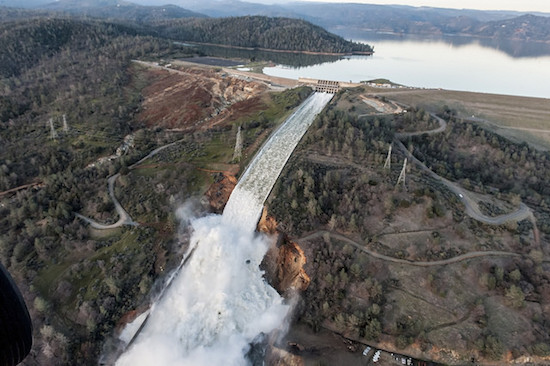SEJournal Online is the digital news magazine of the Society of Environmental Journalists. Learn more about SEJournal Online, including submission, subscription and advertising information.
TipSheet: Oroville Crisis Points to Dam Stories in Many States
 |
| Spillway at California's Oroville Dam on Feb. 14, 2017. Photo: California Governor's Office of Emergency Services, Flickr Creative Commons |
The crisis at California’s Oroville Dam, which prompted evacuation of almost 200,000 people Feb. 12 is really a warning to communities across the United States. Although journalists don’t write about it often, dam safety remains an important issue in many parts of the country.
The Oroville crisis revealed several things that are true in other places:
- Many dams are aging, and outdated engineering combined with physical deterioration can present safety threats.
- Climate change is bringing new weather patterns — precipitation and floods that may exceed what old dams were designed to handle.
- Over the years, population growth and economic development downstream of some dams have made people and property more vulnerable to dam failure.
- In too many cases, emergency plans for handling an imminent dam failure are sloppy or missing.

So if environmental journalists look, they may well find a story like Oroville near them.
If you don’t know where the big dams in your region are, you can find them online using the National Inventory of Dams. The NID, maintained by the U.S. Army Corps of Engineers, may be hard to access all at once, but you can buy a full copy of the data from Investigative Reporters and Editors.
The most important information is censored from the NID and other official federal databases. That includes the dam’s hazard ranking — whether a failure would threaten lives or property downstream. It also excludes ratings of the physical condition of the dam — whether it is sound or crumbling.
The Corps cites homeland security as a rationale for depriving the public of this information. But it is far more valuable to people living downstream of a dam that may collapse in the next deluge than it could ever be to terrorists.
Fortunately, you can get that information with some digging. One place to obtain hazard rankings is from Stanford University’s National Performance of Dams Program database.
Some 4,000 dams are deficient,
and 2,000 of those are high-hazard.
But the best place to get information about the condition of a dam is from the agency that inspects it — which in most cases is a state dam-regulating agency. Those inspection reports are not often online, but they are public documents you can request from the state engineer or regulating agency.
Spoiler alert: Too many dams in the U.S. are in bad shape. According to the American Society of Civil Engineers’ 2013 Infrastructure Report Card, the nation’s dams get a D grade. Some 4,000 dams are deficient, and 2,000 of those are high-hazard.
The next ASCE report card is slated to come out March 9, 2017. That will be a news story by itself — but will be even more newsworthy in light of the “infrastructure” programs that both President Donald Trump and Congress have said they will propose.
One other thing worth finding out about dams near you is whether they have an “emergency action plan,” or EAP, and just what that plan is.
Typically, an EAP shows who is responsible for alerting people of an imminent failure, how and to whom that notification happens, how evacuation will work, etc. If a high-hazard dam does not have an emergency action plan, that should be a news story. Too many don’t.
Of course, crises and disasters grab headlines. But dams are news to environmental (and energy) journalists for a host of other reasons.
For one thing, they provide cheap, renewable, non-fossil-fuel electric power. Also, they are the foundation of major regional irrigated agriculture economies, which have huge environmental consequences (e.g., California’s Central and Imperial Valleys).
Some dams provide outdoor recreation to kayakers and fishers. But, by obstructing streams, dams also can make it impossible for valuable fish like salmon to swim upstream to spawn.
The story of dams often varies by region.
In the East, they may create reservoirs that are used to supply drinking water. Not only does the quality of water stored behind a dam matter in such cases, but the quantity does, too. Climate change may bring drought conditions that dams can help alleviate. Many small dams for farm ponds help conserve soil as well as water.
In some places, earthen coal slurry dams and coal-ash impoundments present special safety risks. In others, dams combined with locks promote the navigation which makes possible regional economies based on grain or coal.
You can find more data, links and story ideas at SEJ’s Data Toolbox on Dams, Impoundments and Levees.
* From the weekly news magazine SEJournal Online, Vol. 2, No. 8. Content from each new issue of SEJournal Online is available to the public via the SEJournal Online main page. Subscribe to the e-newsletter here. And see past issues of the SEJournal archived here.
















